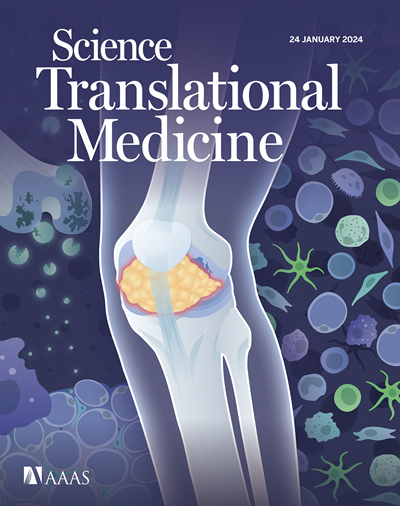Melatonin receptor 1A variants as genetic cause of idiopathic osteoporosis
IF 15.8
1区 医学
Q1 CELL BIOLOGY
引用次数: 0
Abstract
Idiopathic osteoporosis (IOP) is a rare form of early-onset osteoporosis diagnosed in patients with no known metabolic or hormonal cause of bone loss and unknown pathogenesis. Patients with IOP commonly report both childhood fractures and family history of osteoporosis, raising the possibility of genetic etiologies of IOP. Whole-exome sequencing analyses of different IOP cohorts identified multiple variants in melatonin receptor 1A (MTNR1A) with a potential pathogenic outcome. A rare MTNR1A variant (rs374152717) was found in members of an Ashkenazi Jewish family with IOP, and an MTNR1A variant (rs28383653) was found in a nonrelated female IOP cohort (4%). Both variants occur at a substantially higher frequency in Ashkenazi Jewish individuals than in the general population. We investigated consequences of the heterozygous (rs374152717) variant [MTNR1Ac.184+1G>T (MTNR1Ac.184+1G>T)] on bone physiology. A mouse model of the human rs374152717 variant reproduced the low bone mass (BM) phenotype of young-adult patients with IOP. Low BM occurred because of induction of senescence in mutant osteoblasts followed by compromised differentiation and function. In human cells, introduction of rs374152717 led to translation of a nonfunctional protein and subsequent dysregulation of melatonin signaling. These studies provide evidence that MTNR1A mutations entail a genetic etiology of IOP and establish the rs374152717 variant as a loss-of-function allele that impairs bone turnover by inducing senescence in osteoblasts. The higher prevalence of the MTNR1A variants identified in IOP cohorts versus the general population indicates a greater risk of IOP in those carrying these variants, especially Ashkenazi Jewish individuals bearing the rs374152717 variant.
褪黑激素受体 1A 变异是特发性骨质疏松症的遗传原因
特发性骨质疏松症(IOP)是一种罕见的早发性骨质疏松症,患者的骨质流失没有已知的代谢或激素原因,发病机制不明。骨质疏松症患者通常报告有儿童骨折和骨质疏松症家族史,这就提出了骨质疏松症遗传病因的可能性。对不同的眼底病队列进行的全外显子组测序分析发现,褪黑激素受体 1A(MTNR1A)中存在多个变异,具有潜在的致病性。在一个患有眼底病的阿什肯纳兹犹太家族成员中发现了一个罕见的MTNR1A变体(rs374152717),在一个非相关女性眼底病队列(4%)中发现了一个MTNR1A变体(rs28383653)。这两种变异在阿什肯纳兹犹太人中出现的频率远远高于普通人群。我们研究了杂合子(rs374152717)变异[MTNR1Ac.184+1G>T(MTNR1Ac.184+1G>T)]对骨生理的影响。人类 rs374152717 变体的小鼠模型再现了青壮年 IOP 患者的低骨量(BM)表型。出现低骨量的原因是突变成骨细胞诱导衰老,随后分化和功能受损。在人体细胞中,rs374152717 的引入导致了无功能蛋白的翻译以及随后的褪黑激素信号转导失调。这些研究提供了 MTNR1A 突变导致 IOP 遗传病因的证据,并确定 rs374152717 变体是一种功能缺失等位基因,可通过诱导成骨细胞衰老而影响骨转换。与普通人群相比,在眼底病队列中发现的 MTNR1A 变异的发生率更高,这表明携带这些变异的人患眼底病的风险更大,尤其是携带 rs374152717 变异的阿什肯纳兹犹太人。
本文章由计算机程序翻译,如有差异,请以英文原文为准。
求助全文
约1分钟内获得全文
求助全文
来源期刊

Science Translational Medicine
CELL BIOLOGY-MEDICINE, RESEARCH & EXPERIMENTAL
CiteScore
26.70
自引率
1.20%
发文量
309
审稿时长
1.7 months
期刊介绍:
Science Translational Medicine is an online journal that focuses on publishing research at the intersection of science, engineering, and medicine. The goal of the journal is to promote human health by providing a platform for researchers from various disciplines to communicate their latest advancements in biomedical, translational, and clinical research.
The journal aims to address the slow translation of scientific knowledge into effective treatments and health measures. It publishes articles that fill the knowledge gaps between preclinical research and medical applications, with a focus on accelerating the translation of knowledge into new ways of preventing, diagnosing, and treating human diseases.
The scope of Science Translational Medicine includes various areas such as cardiovascular disease, immunology/vaccines, metabolism/diabetes/obesity, neuroscience/neurology/psychiatry, cancer, infectious diseases, policy, behavior, bioengineering, chemical genomics/drug discovery, imaging, applied physical sciences, medical nanotechnology, drug delivery, biomarkers, gene therapy/regenerative medicine, toxicology and pharmacokinetics, data mining, cell culture, animal and human studies, medical informatics, and other interdisciplinary approaches to medicine.
The target audience of the journal includes researchers and management in academia, government, and the biotechnology and pharmaceutical industries. It is also relevant to physician scientists, regulators, policy makers, investors, business developers, and funding agencies.
 求助内容:
求助内容: 应助结果提醒方式:
应助结果提醒方式:


